Asia Textile Market Size
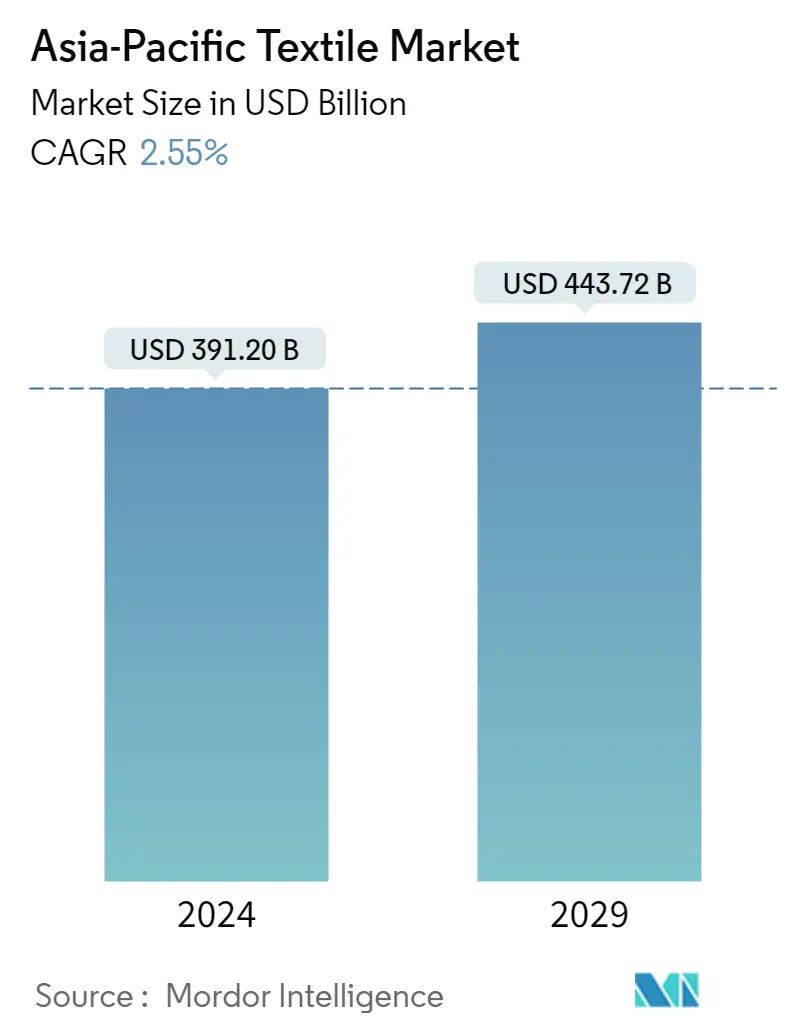
| Study Period | 2019 - 2028 |
| Base Year For Estimation | 2021 |
| Market Size (2023) | USD 381.47 Billion |
| Market Size (2028) | USD 432.69 Billion |
| CAGR (2023 - 2028) | 2.55 % |
| Market Concentration | Low |
Major Players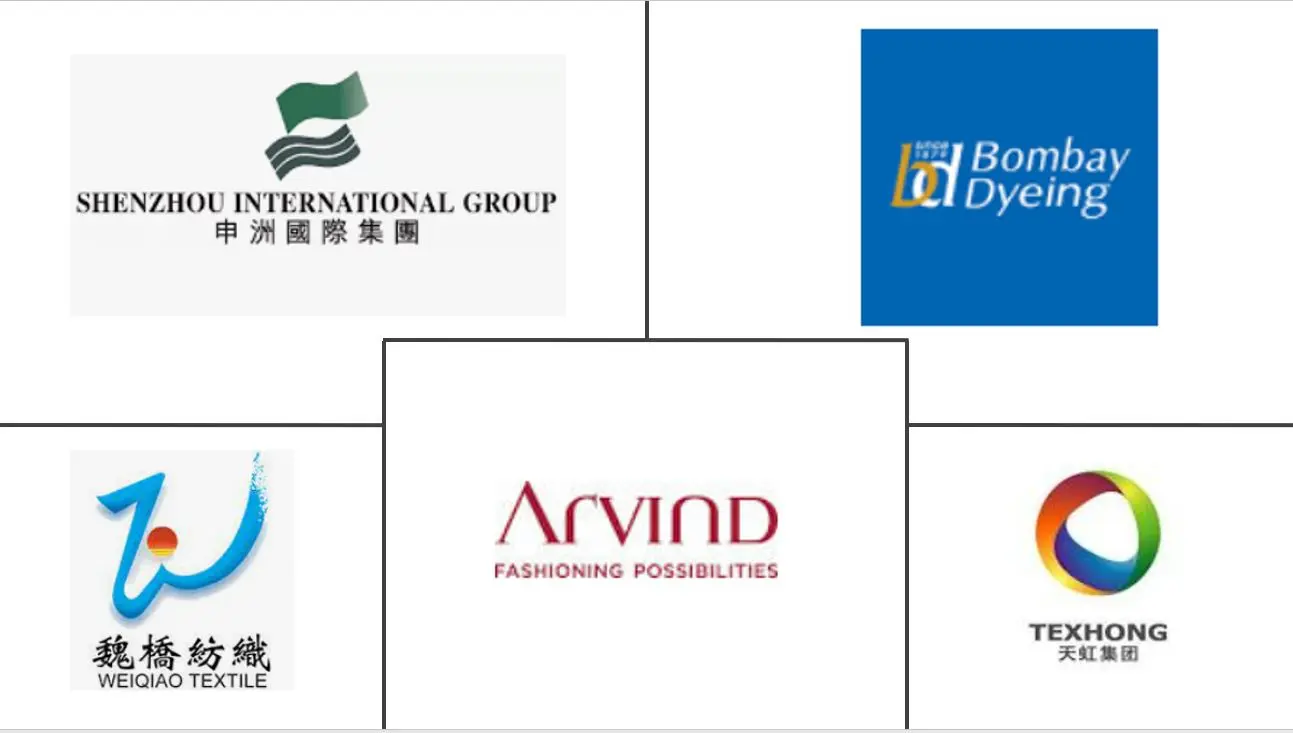
*Disclaimer: Major Players sorted in no particular order |
Need a report that reflects how COVID-19 has impacted this market and its growth?
Asia Textile Market Analysis
The Asia-Pacific Textile Market size is estimated at USD 381.47 billion in 2023, and is expected to reach USD 432.69 billion by 2028, growing at a CAGR of 2.55% during the forecast period (2023-2028).
Increasing demand for clothing and home furnishing products in the Asia-pacific region are the major growth factors.
- The COVID-19 crisis has caused considerable damage and hardship across the global garment industry, affecting brands, manufacturers, and workers in various multitudes. The pandemic has exposed acute vulnerabilities in garment supply chains and the impact that sourcing decisions have on supplier factories and their workers. With the bulk of global garment production in Asia, the region remains the frontline of the adverse effects rippling through the supply chain.
- Asia-Pacific is both the largest and fastest-growing silk market. Due to the easy availability of raw silk, China leads the Asia-Pacific silk market, accounting for approximately 80% of the region's demand for silk. China is also the world's largest producer of raw silk and silk yarns, trailing India, Thailand, and Uzbekistan. The country is the world's leading textile exporter, accounting for roughly 40% of global textile and clothing exports. With over 20,000 enterprises. The Asia-Pacific silk market is expected to expand further as a result of the region's growing economy, rapid advances in sericulture technology, and increased use of silk in the textile industry.
- Thailand is well-known throughout the world as one of the world's largest producers of fabric, sportswear, children's wear, women's wear, and casualwear. Furthermore, the country's exquisite finishing, dyeing, and printing services make it one of the world's most popular textile outsourcing destinations. Thailand currently employs nearly one million people through its 4,500 textile and apparel manufacturers. Most of these manufacturers, based in and around Bangkok and eastern Thailand, produce everything from man-made fibre plants, spinning and weaving, to dyeing and printing.
- According to Bangladesh's Export Promotion Bureau (EPB), the country's home textile export basket includes bed linen, bed sheet and other bedroom textiles, bath linen, carpets and rugs, blankets, kitchen linen, curtains, cushions and cushion cover, and quilt covers. Home textiles earned USD 1.62 billion from exports in the recently concluded fiscal year 2021-22, representing year-on-year growth of 43.28%. It is worth noting that home textiles earned USD 1.13 billion in exports in the previous fiscal year.
- With Asia accounting for the majority of global garment production, the region remains at the forefront of the negative effects reverberating through the supply chain. With the challenges comes a window of opportunity for new alliances and new thinking about the industry's future and, more importantly, how it can be reshaped for a more resilient, sustainable, and human-centered future. Domestic consumers have prompted businesses to reconsider their supply chains, and e-commerce and digitalization have benefited.
Asia Textile Market Trends
This section covers the major market trends shaping the APAC Textile Market according to our research experts:
Increase in Consumer Spending in Fashion Accessories in Asia
Consumer spending on clothing and footwear in Asia is estimated to be USD 756.84 billion in 2021, an increase of 18% compared to 2020, which was around USD 647.26 billion. The ongoing labor market recovery will also aid consumer confidence and, hence, spending. As demand for clothing from Asia (mainly China) grows, the importance of Europe and North America in this sector is declining. Sales of clothing products outside North America and Europe equaled sales in these regions in 2021, and they are expected to reach 55% of the total world sales of clothing products in 2025.
The Asia-Pacific region (Vietnam, the Philippines, Indonesia, Malaysia, Thailand, and Singapore) is highly attractive to the apparel sector, especially because it has a large proportion of young people for whom digital solutions play an important and growing role. The three largest e-commerce websites in this region (Lazada, Shopee, and Tokopedia) saw the gross value of their merchandise sales increase seven-fold between 2018 and 2021.
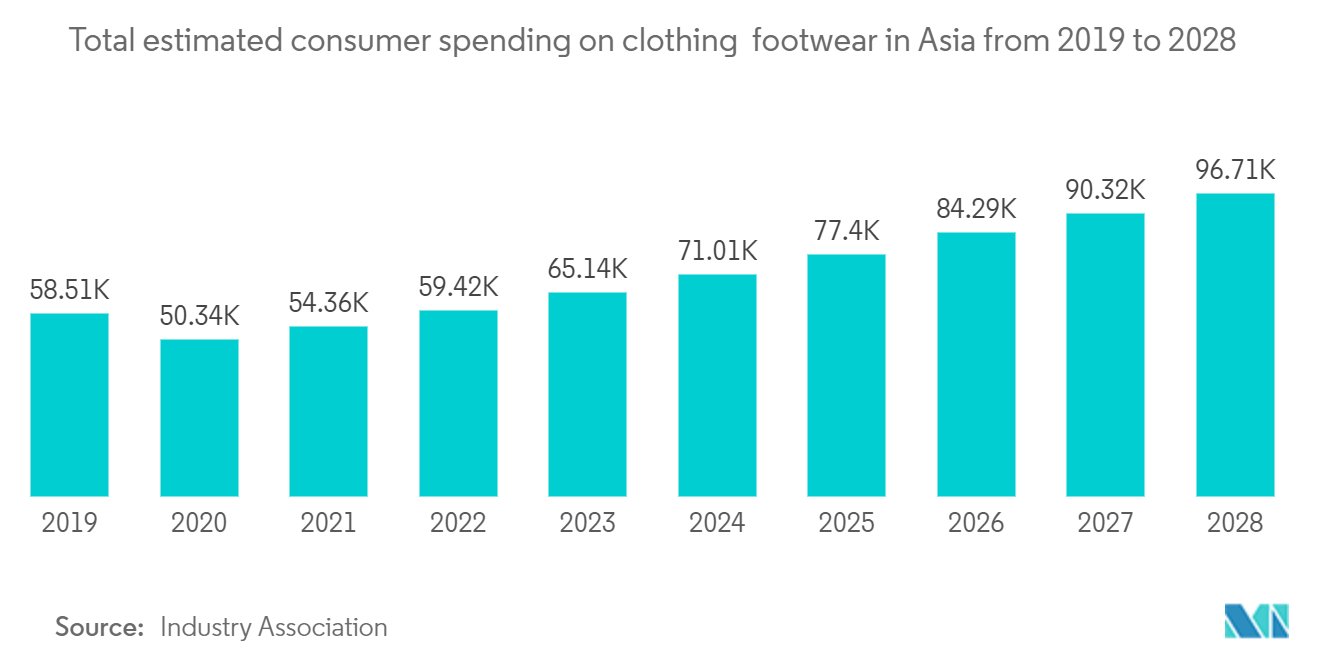
Increase in Exports Boosting Revenue in Asia
In 2021, China was the top-ranked global textile exporter with a value of approximately USD 118.5 billion. Textiles can refer to the materials used in clothing production, as well as the finished garments. After China, Bangladesh ranked in second place, with an export value of around USD 38.73 billion. China’s export figures translate to almost 52.2% of the total textile export market in Asia.
The shift in consumer perception of affordable and comfortable clothing increases the demand for high-value fabrics, such as viscose, silk, and hemp. Blended varieties of fibers are also growing exponentially due to significant features of artificial and natural yarn, thus opening up new markets and growth opportunities in the coming years.
Polyester and cotton are widely used textile yarn products in the region. Changing consumption patterns, increasing population, disposable incomes, and the increasing demand for clothing and home furnishing products in the Asia-Pacific region are the major growth factors.
Also, the demand for home textiles is rising in the APAC region. Home textile includes products such as blankets, bedsheets, table cloths, cleaning and kitchen cloths, drapes, bed covers, sheers, wall carpets, sleeping bags, terry towels, mattresses, quilts, pillows, tapestry, etc., which are utilized in the interiors of homes, hotels, offices, etc.
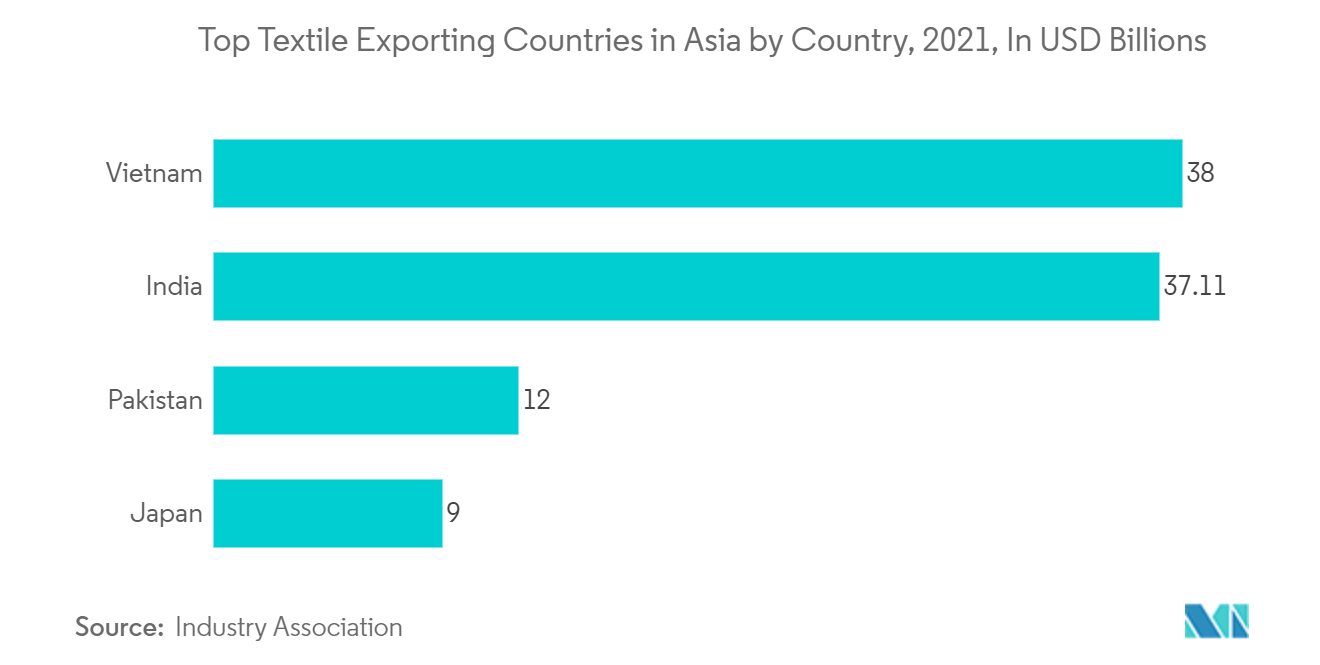
Asia Textile Industry Overview
The Asia-Pacific textile market is highly competitive and fragmented. Some of the companies in the Asia-Pacific Textile industry are Shenzhou International Group, Weiqiao Textile, Texhong Textile Group, Arvind Ltd, and Bombay Dyeing and Manufacturing Company Ltd. There are numerous local companies which are restricted to their locations but with technological advancement, internet and e-commerce penetration has driven the market even in the hard times. Further, integration of the market followed by mergers, partnerships and acquisitions will help the companies to create a strong foothold in the market.
Asia Textile Market Leaders
Shenzhou International Group
Weiqiao Textile
Texhong Textile Group
Arvind Ltd
Bombay Dyeing and Manufacturing Company Ltd
*Disclaimer: Major Players sorted in no particular order
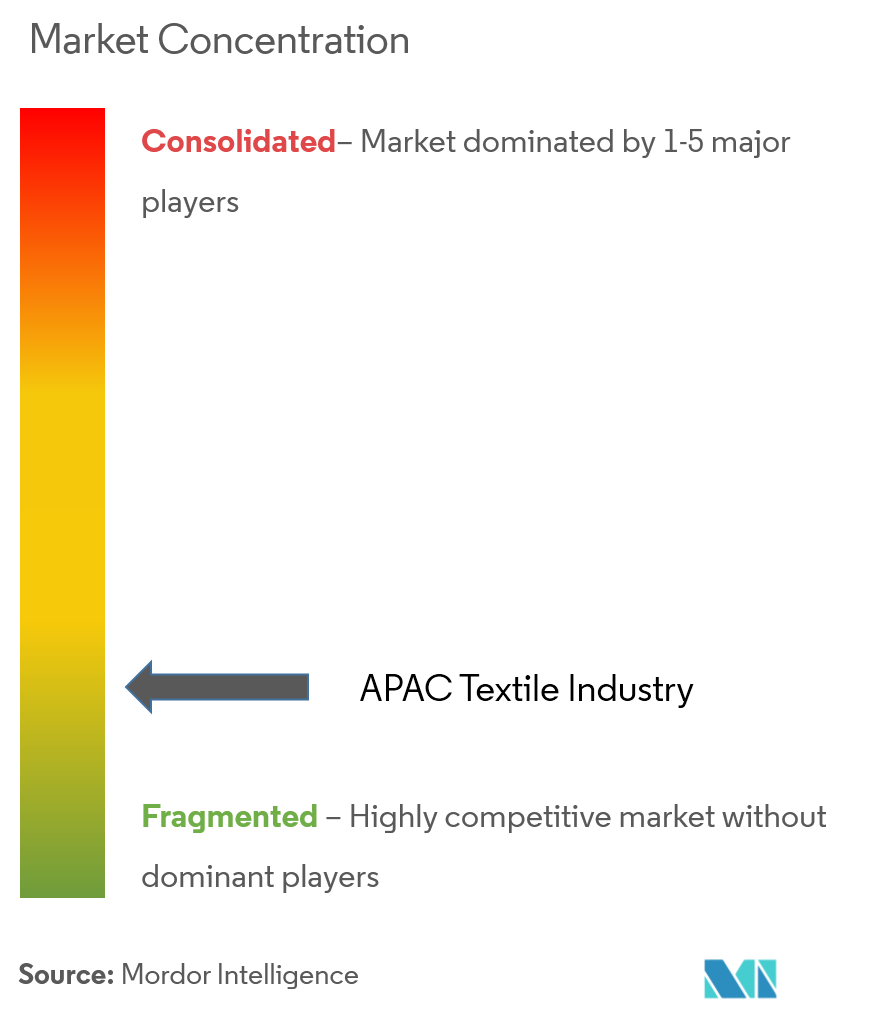
Asia Textile Market News
- May 2022 – Texhong shared plans to establish a key facility in Vietnam to sharply boost its fabric production. The move was taken in a bid to complement the company’s cotton-based yarn business.
- May 2022: LANXESS and Advent International signed an agreement to acquire the DSM Engineering Materials business (DEM) from the Dutch group Royal DSM, which will become part of the new joint venture. The purchase price is around EUR 3.7 billion and will be financed by the joint venture via equity from Advent and external debt. The business represents sales of around EUR 1.5 billion with an EBITDA margin of approximately 20 percent.
Asia Textile Market Report - Table of Contents
1. INTRODUCTION
1.1 Study Assumptions
1.2 Scope of the Study
2. RESEARCH METHODOLOGY
2.1 Analysis Method
2.2 Research Phases
3. EXECUTIVE SUMMARY
4. MARKET INSIGHTS AND DYNAMICS
4.1 Current Market Scenario
4.2 Market Dynamics
4.2.1 Drivers
4.2.2 Restraints
4.2.3 Opportunities
4.3 Value Chain / Supply Chain Analysis
4.4 Porter's Five Forces Analysis
4.4.1 Threat of New Entrants
4.4.2 Bargaining Power of Buyers/Consumers
4.4.3 Bargaining Power of Suppliers
4.4.4 Threat of Substitute Products
4.4.5 Intensity of Competitive Rivalry
4.5 Supply Chain/Value Chain Analysis
4.6 Technological Trends and Automation
4.7 Government Regulations and Initiatives
4.8 Insights into the E-commerce Market
4.9 Impact of COVID-19 on the Market
5. MARKET SEGMENTATION
5.1 Application
5.1.1 Clothing
5.1.2 Industrial and Technical
5.1.3 Household
5.1.4 Other Applications
5.2 Material
5.2.1 Cotton
5.2.2 Jute
5.2.3 Silk
5.2.4 Synthetics
5.2.5 Wool
5.3 Geography
5.3.1 China
5.3.2 India
5.3.3 Pakistan
5.3.4 Bangladesh
5.3.5 Australia
5.3.6 Rest of Asia-Pacific
6. COMPETITIVE LANDSCAPE
6.1 Market Concentration Overview
6.2 Company Profiles
6.2.1 Shenzhou International Group
6.2.2 Weiqiao Textile
6.2.3 Texhong Textile Group
6.2.4 Arvind Ltd
6.2.5 Bombay Dyeing and Manufacturing Company Ltd
6.2.6 Bombay Rayon Fashions Ltd
6.2.7 Fabindia Overseas Pvt Ltd
6.2.8 Raymond Ltd
6.2.9 Vardhman Textiles Ltd
6.2.10 Cotton Corporation Of India*
- *List Not Exhaustive
6.3 Other Companies
7. FUTURE OF THE MARKET
8. APPENDIX
Asia Textile Industry Segmentation
The textile industry involves sections like research, design, development, manufacturing, and distribution of textiles, fabrics, and clothing. A complete background analysis of the Asia-Pacific Textile Market, including the assessment of the economy and contribution of sectors in the economy, market overview, market size estimation for key segments, and emerging trends in the market segments, market dynamics, and geographical trends, and COVID-19 impact is included in the report.
The Asia-Pacific textile market is segmented by application (clothing, industrial and technical, household, and other applications), by material (cotton, jute, silk, synthetics, and wool), and by geography (China, India, Pakistan, Bangladesh, Australia, and Rest of Asia-Pacific). The report offers market size and forecasts for the Asia-Pacific Textile Market in value (USD Billion) for all the above segments.
| Application | |
| Clothing | |
| Industrial and Technical | |
| Household | |
| Other Applications |
| Material | |
| Cotton | |
| Jute | |
| Silk | |
| Synthetics | |
| Wool |
| Geography | |
| China | |
| India | |
| Pakistan | |
| Bangladesh | |
| Australia | |
| Rest of Asia-Pacific |
Asia Textile Market Research FAQs
How big is the Asia-Pacific Textile Market?
The Asia-Pacific Textile Market size is expected to reach USD 381.47 billion in 2023 and grow at a CAGR of 2.55% to reach USD 432.69 billion by 2028.
What is the current Asia-Pacific Textile Market size?
In 2023, the Asia-Pacific Textile Market size is expected to reach USD 381.47 billion.
Who are the key players in Asia-Pacific Textile Market?
Shenzhou International Group, Weiqiao Textile, Texhong Textile Group, Arvind Ltd and Bombay Dyeing and Manufacturing Company Ltd are the major companies operating in the Asia-Pacific Textile Market.
Textile in Asia Industry Report
Statistics for the 2023 Textile in Asia market share, size and revenue growth rate, created by Mordor Intelligence™ Industry Reports. Textile in Asia analysis includes a market forecast outlook to 2028 and historical overview. Get a sample of this industry analysis as a free report PDF download.
